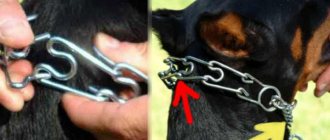The course has been updated in June 2022! Many improvements have been introduced.
Learn basic training skills for your dog online! The best option for taking the first steps in education. The videos were filmed by Irina Chushikina, a dog handler with 10 years of experience.
| Number of videos | Price |
| One lesson | 1,000 rub. |
| Entire course (5 lessons) | 6,000 rub. 5,000 rub. |
The most important commands
Not all of them are equally useful in the life of the owner and his pet. Babies under 3 months old will not benefit from “adult” training methods at home. Puppies are trained according to programs. These instructions are relevant to owners of animals older than 3 months.
Each of them is important. Even the most seemingly “insignificant” of them cannot be ignored. On the contrary, it is worth further familiarizing yourself with each technique.
Must know and perform:
Take the Attention Test! Find 10 differences! (click right here!)
Find the answer Are you bothered by some problem or question? Enter “Breed” or “Name of the problem” into the form, press Enter and you will find out everything about the issue that interests you.
- "To me". This is the most famous team. It is used more often than others. Learning the technique can be practiced during class or during a regular walk.
- "Near". Almost as important as “to me.” Animals usually learn it by the 4th-5th lesson.
- "Ugh". It will help you not to worry that your dog will get into the trash heap or eat, say, rodent poison. Extremely important for the health of the pet and the nervous system of the owner.
- It is worth starting to develop endurance in a four-month-old puppy. Not a single serious activity with a pet can be done without it. Self-control helps control the dog and develops the animal’s obedience.
- "Give". Useful for every well-mannered dog. For ministerial servants who make protecting their household their life's goal, this technique is important. An animal that perfectly executes “give” can neutralize an attacker on its owner and then release it.
It is used when playing with a thrown toy and a stick. Experts do not recommend teaching your dog the “give a paw” technique. Dogs quickly learn this and begin to “hello” their owner every time he bends down.
- "Sit". The simplest command that can be useful in everyday life or for training itself.
- "Lie". It is easy to teach a pet. You may need it, for example, at a veterinarian’s appointment.
- "Stand". This one is more complicated. Although it is used more often than "sit". Beginners are often lost when learning; patience and perseverance should help them master a useful exercise.
- "Place". It is useful for a dog to know where its place is in the house and to go there on command. The dog may sleep in a completely different place, but he must know his own.
- "Aport." Helps you walk your active pet. With its help, service dogs search the area.
- "Fas." A dangerous command if the dog does not know how to obey. An untrained dog cannot be trained.
This is what the list for the basic pet training course looks like. To make classes more effective, you need to stock up on treats for your “student”. It should be something tasty for the dog and easy to carry. Everyday pet food is not suitable; the dog understands well that he will receive it without additional effort.
Rules and methods for teaching dogs commands
There is an opinion that it is impossible to train an adult dog: supposedly, it is possible to master all stages of the training course only in puppyhood. It's a delusion. Of course, kids learn faster and absorb information more easily, but adult dogs can also be trained. The main thing is to conduct training regularly, competently and be patient, not to get nervous when an adult dog does not learn a lesson very quickly.
It is best to conduct training in a place familiar to your pet. It is desirable to have no distractions: cars, passers-by, other dogs, etc. If an unfamiliar territory is chosen, the animal must first study it, examine it, in order to eliminate possible dangers and calm down.
You should not conduct training immediately after waking up or after eating. During the summer, it is not recommended to train in the middle of the day, as this can cause dehydration, overheating and all related problems. If there is no other option, take enough drinking water for your pet.
Don't forget to bring treats to class. Consider your pet's preferences. For some dogs, the most delicious thing is dry food, for others - a piece of meat or a slice of cheese. In pet stores you can buy special cookies for training purposes.
You can reward your dog not only with something tasty, but also with praise and affection. This must be done correctly. If you reward your pet for some action, you need to praise it right away. If the command has already been completed and some time has passed, the reward will be misunderstood by the pet.
If you decide to go through a training course with your pet yourself, pay attention to the following recommendations
:
- Classes should be regular, ideally daily. The duration of training should increase gradually. For the first lessons, 15 minutes is enough.
- Commands must be given clearly, with special intonations. The dog must distinguish between the intonations of commands and encouraging words.
- An order must be repeated no more than twice if the student did not complete it the first time, otherwise it will lose its value. The dog will think that fulfilling the requirement is not necessary, and it can be fulfilled the tenth time.
- Before you command, you need to attract the animal’s attention - say its name.
- You must not lose composure if your pet fails in training, become nervous, raise your voice, much less beat the animal.
- For success, do not forget to reward your four-legged friend with a kind word or a tasty bite.
Conduct initial classes in the same area. After the dog gets used to the training, the place can be changed.
Time, place, duration
Some lazy owners hope to get by with training at home. To be fair, commands such as “fu”, “lie down”, “nearby” can be taught easily. At home, a “trained” pet will learn to obey, but on the street it will prefer to behave as it sees fit: run after the cat or bury its head in a trash can.
A well-mannered dog needs real exercise in the fresh air. It’s worth stocking up on dog treats, taking a collar and leash, and going with your devoted pet to a place where no one should interfere. The first training sessions should take place in a quiet place. Gradually, exercises can be practiced with the participation of stimuli (people, other dogs.).
Classes must be systematic. Select 3 days a week. Let's say Tuesday, Thursday, Saturday. If you are very busy at work, you need to give your pet at least 2 days a week.
It is recommended to start with 35-45 minutes. In the future, classes should be increased to 1-1.5 hours. Roughly speaking, it will take 2-4.5 hours a week to raise a dog.
We begin the educational process:
- First training. The dog must learn the commands: “come to me”, “lie down”, “sit”, “next to me”. Get to know endurance. The technique of endurance and “come to me” should be practiced while walking with an animal.
- Second. The same exercises are processed as in the first one.
- Third. The command “stand” is added. The classes will be longer, they should be 45-60 minutes.
- Fourth. The emphasis is on execution technique.
- Fifth training session and that's it. Processing already familiar commands. You need to strive for perfect execution. A half-trained dog can sometimes be more dangerous than an untrained animal.
“Come to me” - practice at home and while walking the dog. It is worth calling the dog when he is lying down.
“Fu” is one of the useful ones. During exercise, you can scatter food around the training area yourself. Any attempt to eat the treat must be stopped with a strict “ew”. You need to pull the roulette leash sharply. The punishment for wrongdoing must be quite serious. After treatment, you can play with your pet or switch to another technique.
The “place” command can be taught to your dog both at home and on the street. At home, it is needed so that the pet goes “to itself.” And on the street, so that he returns to the previously designated place. It is used to train techniques such as “lying” or “sitting”. It is needed for the animal's obedience.
Techniques such as “give” or “fetch” begin to be taught while walking. At first they look like a game. Often they use a puller or rubber toys from the pet store. During classes, practice should take place in a more formal form, without the use of games.
As mentioned above, “fas” is a serious team. Only a specialist can teach it to a dog. Dog handlers are confident that the dog must be well-mannered and obedient. Experts, even with a perfectly trained dog, conduct several obedience training sessions before moving on to a protection course and learning it.
If we talk about the sequence of execution, the main rule is this: in order to quickly train your pet and work out all the techniques, the sequence should not be repeated.
In practice, the lesson might look like this:
- Work with the team “nearby” lasts up to 10 minutes;
- The same amount of time should be spent practicing the techniques of “standing”, “sitting”, “lying down”;
- You can repeat “next to”;
- Spend a little less than 10 minutes on exposure;
- Practice the “fetch” and “give” techniques for up to 10 minutes.
The next time you practice, the order may be different. This way the dog will quickly learn to carry out the necessary commands.
Why do you need training and where to start?
A puppy in the house is a long-awaited joyful event. But not every owner understands that a dog’s behavior can be very different from the rosy ideas of cohabitation. Animals live according to the laws of the pack, behave as their instincts tell them.
To prevent the days spent side by side with the dog from becoming unbearable, training with the puppy should be carried out daily. A poorly trained pet, even the smallest one, can turn into a real tyrant, terrorizing the entire family and immediate environment.
A dog that is not trained in commands chases cats and jumps on strangers, scaring them. The dog can break off the leash at any moment and end up under a car.
When to start training your puppy
From remnants of Soviet times, many people are sure that training should begin no earlier than the puppy is 6 months old. In many military canine bases, dogs that have reached half a year of age are still taken to the training ground. This is due solely to the method of education; most military specialists work through coercion, which is really not suitable for small puppies.
Along with a general training course, army dogs are trained in special skills:
- Searching for a person by following a trail;
- Sampling of things;
- Search and Rescue Service;
- Territory protection;
- Frontal attack;
- Detention of a criminal;
- Protection of the owner (and the things left behind);
- Search for explosives and narcotic substances.
Very small puppies are not yet suitable for special training. But a dog living in a family as a companion must begin to learn the basics of education from the first days of its arrival in the house.
A puppy aged from 3 to 7 months is trained well and quickly. This period in cynology is called “the time of deep memory.” The commands that the dog mastered at this time are remembered for a long time, without lengthy repetitions.
Preparation for training
Before starting to learn commands, the instructor must get to know the puppy, gain trust - pet it, play with it, or treat it with a treat. The first lesson should be carried out in a room that is familiar to the baby or a permanent place for walking.
The dog must first be walked to satisfy its natural needs. If the dog wants to go to the toilet, it will be difficult for him to concentrate on the trainer.
There should be no strangers or animals at the site of the first lesson so as not to frighten or distract the puppy. At the initial stage of training, it is very important that the pet’s attention is completely captivated by the instructor.
Necessary ammunition
Before starting classes, you must purchase the appropriate equipment:
- Soft leather or nylon collar;
- Leash 1 – 1.5 meters long;
- Leash 5 – 15 meters long;
- A motivating treat or toy.
All equipment must be suitable in size for the dog and be strong enough not to tear during exercise.
What should a novice trainer remember?
To prevent training from turning into torture, you need to consider a few more points:
- Any workout can be made easier. To do this, you need to take your pet for a good walk in advance. A tired, running dog will be less distracted. This means the effect will be greater. According to experienced owners, active walking makes working with the animal several times easier.
- Each command is spoken only once. They cannot be duplicated. The dog quickly grasps, if he understands that the owner can repeat the same thing several times, then he will stop performing the technique the first time.
- There must be pauses between teams. When practicing, for example, “near”, “lie down”, “fetch”, you need to give the dog time to take a breath. 5-10 seconds will be enough. If you do not pause, the dog may simply become confused.
- It's important to change the sequence. During training, it is better to practice all techniques separately. If the dog gets used to doing everything in order, nothing good will come of it in the end. Unless he develops a reflex. That, for example, after “to me” you need to “sit.” The dog must master commands in any sequence.
- You cannot overload your student. Too intense training can harm your four-legged friend. We must always keep in mind that a dog is a living creature. She may have some pain. Or not being in the mood to study.
An already trained dog is able to perfectly carry out commands under any conditions. But we must keep in mind that your pet may get tired.
- Sometimes students, like ordinary schoolchildren, “run away from class.” They may be distracted by a nearby cat or other dog. This can be avoided if you are more careful about exposure. Train her on a long leash. This will allow you to catch up with the “mischievous person”, even if he runs fast. A leash with a carabiner for 3-5 meters is suitable. Often such a leash is just needed for endurance and training to pick up “goodies” from the floor.
- “Mass” training is not allowed. Only the dog's owner should act as a trainer. The dog must obey all family members. And pets must master the basic principles of raising an animal. But at the training itself there are only two people: the owner and his pupil. Otherwise, the dog will be constantly distracted.
- Sometimes during training it is worth pausing. It happens that the dog looks scared. He follows commands, but seems to doubt the correctness of his actions. The reason is usually that the owner was too strict and overdid the load. In such cases, you need to get the dog to fulfill the simplest command for him, and then generously praise him. More than usually. The dog, seeing that the owner approves of him, will begin to perform the exercises better. You can even play with the dog or take it for a walk.
- To develop the ideal execution of techniques, they need to be studied systematically, gradually. It is necessary to teach your pet to follow commands in any conditions. Start with perfect obedience in a calm place, gradually adding “stimulants”. They can be created artificially. For example, scattering treats. Or invite a friend to walk past your training place at a certain time. You can come up with “irritants” yourself or read reviews from experienced owners.
To train an animal, you need to be patient, free up a few hours a week, and most importantly, do the exercises systematically. These are the basic rules that will help raise a trained dog from a “wild animal”. Further training can be complicated. You should get off the couch, take your pet for a walk, and go look for a suitable place for training.
Paid dog training
Many of you want your dog to know many different commands, but you don’t have the time or energy for this. Therefore, many turn to training professionals, namely dog handlers. But not everyone will be able to afford to take their pet to dog handlers, because these services are paid. Many owners are interested in how much it costs to train a dog.
The price is different for everyone, because:
- 1) it depends on the training program that you would like to undergo for your pet;
- 2) qualifications of the trainer himself;
- 3) the place where you will conduct your training.
Any breed of dog can be trained. It all depends on the desire and financial situation of the dog’s owner.
During the first lessons, the dog will be taught standard commands, such as: sit, lie down, next to me, not allowed, and others. If you plan for your pet to take part in competitions, then it is better to continue training more complex teams after standard training.
Upon completion of training, your pet will be issued a special certificate. With this document, your dog will have the opportunity to take part in competitions.
A pleasant surprise or reward for work
During house training, the animal should be rewarded with a tidbit:
- Any correctly performed action is reinforced with encouragement, and the next repetition is perceived as a signal to action.
- Dogs who love to eat and food eaters perceive the reward of a treat well. But dogs that are not greedy for food quickly grasp the essence of the owner’s requirements.
- For treats, you usually take what the dog likes: hard cheese, cookies or sausage.
- It is pre-cut into small, pea-sized balls or pieces, and placed in a bag or a special bag hung on the belt. From such a bag it is convenient to take out treats one piece at a time, the small size of which prevents the dog from getting full and losing interest in activities.
The treat is given only after completion, and it must be taken out quickly and unnoticed by the pet.
Should I adopt an adult sick dog?
Often, out of pity, people take a wounded or crippled dog into their home. Such an act is certainly worthy of deep respect. If you want to adopt a sick adult dog, you must have certain skills in communicating with animals and providing first aid to them. If you do not have such experience, it is better to entrust the care of the dog to a veterinarian, and then try to place it in good and, most importantly, capable hands.
Very often, new owners do not suspect that contact with stray dogs can pose a serious danger not only to them, but also to others: such animals are often carriers of various diseases. In addition, a stray dog may have a bad character and it will be extremely difficult to re-educate him (if at all possible, since his character and habits have already been formed in adulthood). Remember: a sick or injured dog sometimes needs to be treated constantly, so seriously consider whether you are willing to make such a sacrifice.
How to distinguish an abandoned dog from a lost one? A lost dog is easy to recognize. See if she has a collar with a tag on it. If there is nothing like that, check for a mark in the ear or groin (in purebred dogs) or a chip (many animals, especially valuable and rare breeds, are microchipped). If you happen to come across a dog with such signs, try to return it to its owner. If you have a brand, contact the kennel club; if you have a chip, contact a veterinary clinic.
Sometimes the dog only has a collar and it is clearly visible that it is domestic (clean fur, eyes and ears, well-mannered, perhaps even following some commands).
Post notices about the find within a radius of 0.5-1 km from your home, write on the Internet, call kennel clubs and dog trainers.
Differences in learning
There are no differences between training a German Shepherd at home and a dog of another breed, except that the ability to quickly remember commands and the desire to do everything perfectly put the German in first place.
From a very young age, German puppies want to learn. They quickly become accustomed to neatness, and even before 4 months of age they are able to perform “voice!”, give a paw, and several other requirements that the owner uses in everyday life.
A German Shepherd can begin to be trained at home as early as 4-5 months, and although this breed has an enviable temperament, they master commands for endurance from the very first lesson. Calling and fetching—dogs perform these tasks with great pleasure.
“Next” is a little more difficult to learn, because in parallel with training, ring training is often carried out for the puppy, in which he must walk, pulling on the leash. Teaching a German Shepherd the command “near!” start a little later than usual.
Useful tips from professionals
List of useful tips from a dog handler:
- You only need to say the command once (the only repeated command is “near”).
- Every action performed correctly must be rewarded (at the learning stage).
- Never punish a dog after calling “to me” (no matter how long, you don’t have to wait for it).
- Classes should be short-term, but daily.
- It is strictly forbidden to use corrective equipment for puppies under one year of age.
- The role of socialization in training should not be underestimated.
Raising a true companion is long and laborious, but it's worth it. A well-trained pet will not cause discomfort to others, and will not be in danger of urban conditions (escapes, cars). An obedient dog is the pride of a worthy owner.
3.7 / 5 ( 4 voices)
We train
Like small children, puppies of any breed love to play, so training babies at home is carried out in a playful way.
While walking, you can learn the command “come to me!” - the most important. Throughout his life, the dog should associate calling with pleasant stroking, treats and approval from the owner during training at home. If a dog has caused trouble but comes up on its own when called, it is prohibited to punish it!
Call the puppy when he calmly examines the surroundings. You need to sit down, take a treat in your hand and cheerfully call the baby. You can say a nickname, but only to attract the pet's attention. When the dog runs up, you need to treat him and praise him loudly. Periodically calling the puppy, reinforce the training.
An adult dog commands “come to me!” teach by stepping back from the dog a few steps and slightly tightening the leash. It is necessary for the animal to understand what is wanted from it.
If at first the puppy is required to simply run up, then the task becomes more difficult for an adult. When the dog approaches, you need to sit him in front of you, and only then give him a treat, or lead him around and sit him down. Refreshments are given only after landing.
An adult dog in a new home: pros and cons
There are pros and cons to keeping an adult dog in a new home. First of all, decide whether you need an adult dog. Of course, she has a number of advantages over a puppy: a well-mannered dog will not have to be taught to be clean, he will not ruin furniture, shoes, wallpaper and laminate flooring, and he will not bother you at night. However, do not forget that the animal may not be raised the way you want. Get ready for the fact that your new adult family member will not be perfect: he will be harder than a puppy, he will endure a change of environment and will not immediately recognize you as the leader.
At first, he will be afraid of the new home and, despite daily walks, go to the toilet anywhere. In addition, the dog may withdraw into itself and become depressed.
Be sure to find out why previous owners give away or sell an adult dog. It is quite possible that the dog has health or mental problems that are not noticeable at first glance. Let the specialist carefully examine the animal and study its veterinary passport.
Another disadvantage of purchasing an adult dog is its established habits and character. She may be afraid of explosions of firecrackers, fireworks, thunder and other strong sound or light stimuli.
If you decide to adopt an adult dog, you must be absolutely clear about all the possible problems that may arise. Are you ready to be patient and put up with (within reasonable limits) the habits of an adult dog?
If you want to adopt a dog from the street, know: many dogs really want to get into a new family, to find a reliable and fair friend. Such animals demonstrate in every possible way how pleasant it is for them to communicate with you: they run after you, caress you. As a rule, street mongrels are quicker than their purebred counterparts to accept the role of a companion dog.
Remember that at first you will be a stranger to the dog, and it is up to you whether he will respect you. Try to calmly, without disruption or stress, adjust the dog’s behavior to suit you and your lifestyle.
However, sometimes homeless animals behave aggressively, laying down their ears, growling, tilting their heads forward, barking and even trying to attack. Such actions can be demonstrated not only by a large dog, but also by a very small mongrel. Even if your heart swells with pity, a dog that is aggressive towards you (provided that you do not threaten it, tease it or provoke it) should under no circumstances be taken into your home! The best advice on how to socialize an adult dog in a new home, raise and train it can only be given by professional dog trainers or experienced owners.
If you do bring a dog into your home from the street, first carefully examine it and immediately show it to the veterinarian. After the examination, if everything is in order, wash the dog, treat it with a drug against external parasites, and get rid of worms.
Learning differences
It is possible to predict the extent to which a representative of the breed is able to quickly remember, patiently perform endurance exercises, or walk well next to each other.
Ability to learn at home depends on hereditary data, breed, and to a large extent, on the individual temperament and preferences of the pet. Both huge Newfoundlands and miniature Yorkshire terriers are trained at the same time on sites and at home, and there are no particular differences between the training methods. A dog of any breed is able to undergo OKD.
What is OKD?
The general training course (GTC) was developed by Soviet dog handlers about a century ago. This is a school that allows you to correct a dog’s behavior and instill unconditional obedience in it. The strict requirements that are imposed on each dog during the course are recognized as basic, and the level of proficiency in the standards is checked at all specialized competitions.
Definition of OKD
OKD has not lost its relevance all these years, surpassing all new techniques in its effectiveness. The course must be completed by:
- four-legged rescuers and police officers;
- service dogs;
- fighting dogs acting as a guard in a private home.
As a rule, fighting breeds are born with too much energy and hidden aggression. If they are not directed in the right direction with the help of OKD, the uncontrolled aggression of dogs will become dangerous for other animals and people. In addition, OKD is also suitable for ordinary pets. The courses will help owners establish good contact with their dog, gain complete control over it and receive only positive emotions from walks.
Courses help owners establish good contact with their dog
Character
The dog’s character, his temperament and individual inclinations play an important role in the success of training at home:
- Some dogs cannot sit still and are active, which means they need a short walk before training.
- Others are lazy and imposing, do not want to get up from their seats - they need to conduct classes in the morning.
- Stubborn, dominant pets should begin training as early as possible, so that by the time they reach puberty, the dog already understands who is in charge in the family. This applies to dogs of vicious breeds, which are easier to deal with while they are small. For example, a one-year-old Alabai who wants to show his character will be difficult to tame.
- Sensitive, vulnerable, emotional pets should be trained gently, without the use of harsh jerks and shouts. This applies to some decorative breeds, to bitches.
- In most breeds, sexual dimorphism is clearly expressed: females are always smaller than males and have a more sensitive and vulnerable character. When trained, bitches are more understanding, obedient, and prone to complete submission to the owner.
How to socialize an adult dog: introductions, behavior options
Getting to know an adult dog should be friendly and calm, regardless of whether it is a mongrel or a purebred dog, small or large. First, determine how the animal reacts to you. Everything should be peaceful, without aggression and anger. Now you can get acquainted.
When you get closer, do not try to pet the dog right away. Perhaps the adult dog will not notice you at all and will go to his place or to the enclosure. This is normal for the initial stage of addiction, but only if there is no obvious aggression or panic. Try sitting down and calling the dog to you by calling its name or showing it a treat or toy. It's best if she comes up on her own. Until the animal wags its tail in response to kind words, showing that you are not dangerous, there is no need to pet it. Calmly extend your open palm forward and let the dog reach out and smell it. After this, try to stroke the animal, but not from above the head, but from below under the jaw, scratch the side of the neck or muzzle.
If the animal reacts aggressively, cannot calm down, does not make contact, do not take it, even if the owner refuses money and assures that the dog usually does not behave this way.
Every dog is unique and original in its own way. However, there are common behaviors in dogs.
When encountered, a cowardly dog bends down to the floor, tucks its ears and tail, whines, and tries to jump to the side or run away altogether. Such a dog has difficulty adapting, is afraid of loud voices and sharp sounds, strangers, other animals and unusual objects. If you're lucky, the dog will soon calm down a little, but in a critical situation, cowardice may appear again.
A cowardly-aggressive dog has all of the above signs, sometimes it attacks, barks loudly, tries to attack and immediately recoils in fear. In a state of panic, it can become almost uncontrollable, not respond to commands, and seriously injure a weak or frightened person. If someone gives a noticeable rebuff, the animal runs away squealing.
A dominant aggressive dog sometimes attacks without warning, silently, actively, often fights with other animals, and may bite a stranger for no reason while walking. It is difficult to care for such a dog; he simply will not perceive your actions. Only a canine instructor or even an animal psychologist can accustom him to the new order. But still, in our opinion, this animal should be abandoned.
A mentally adequate dog, when meeting you, will either not pay attention to you, or will show some calm interest: it will come up, quietly sniff, and allow itself to be stroked. With further proper handling of such an animal, no problems should arise.
If you buy a dog from an owner, ask him for all the dog equipment, toys, bowls and even bedding - this will make it much easier for the animal to get used to new conditions. If you decide to adopt a dog from the street, be sure to take care of everything necessary for it.
Your task is to immediately establish strict rules and strictly follow them in the future. This will help the pet quickly gain respect for you as its owner-leader and take its place in the family.
Deadlines
A dog can be trained at home from the age of 2 months.
First, the puppy is taught simple commands that are necessary in everyday life: “come to me!”, “show your teeth,” “walk!”, “sit,” “toilet.” If the dog lives in an apartment, then the “give me a paw” command is needed to wipe his paws after going outside. After a course of vaccinations, at 4 months, you can begin full training, making it a rule to work with your pet every day. Before the start of classes, the owner takes a treat and says: “practice!”
Soon the puppy will understand what this command means and will be ready for the next lesson, and all kids approach this differently. The lazy ones look disappointed, the “excellent” students jump joyfully in anticipation.
With or without a leash
The leash serves as an extension of the owner's hand; with its help, a person can easily control the dog, even at a distance of several meters.
With the leash you can jerk, pull and speed up the dog's movement, pull or push. At first everything is practiced only on a leash. Without a leash, training can be carried out at home, but then the method of influence should be a clicker or any other signaling device. Before starting training at home, the pet is accustomed to the signal, developing a conditioned reflex in it by giving a treat when it clicks. Clicker training is a fun process, but beginners must first gain experience with a clicker.
What determines a puppy's behavior?
The behavior of any animal is based on reflexes: conditioned and unconditioned, which are also called instincts. A dog is born with a set of unconditioned reflexes, while conditioned ones are formed throughout its life. And the presence of certain conditioned reflexes, as well as their diversity, determines what kind of pet will be - obedient, cowardly, aggressive or something else.
It must be remembered that all interactions in the animal world are built on the principle of hierarchy: the subordination of a weak individual to a stronger one. At the same time, who will take the dominant position is constantly checked, that is, the animal will always try to take a higher place, and if possible, the place of the leader, including through aggression.
Release dates
At home, he follows commands much better than on the street. This is due to the absence of irritants to distract the pet. Training should be carried out in different conditions: on a noisy street, in a field or on the way for a walk, and even at home. It must be performed anytime, anywhere.
Often, a puppy is allowed to leave its yard after a course of vaccinations. Often quarantine ends at the age of 3-4 months, then you immediately need to put your pet on a leash and go for a walk.
This is necessary for the physical development of the pet, for its correct mental perception of the world around it. Socialization is mandatory for representatives of all breeds.
Speed of memorization
A puppy can learn one favorite command in 3-5 repetitions at home, but it will take several weeks to practice another.
The memorization period is always individual, and if you work with your pet daily, then it will take several months to accurately carry out the command at home or in other conditions and at any distance. The usual command “sit!” is absorbed by the puppy quickly; as the pet grows, the execution of the command during training becomes more complicated, forcing it to be performed at a distance of one meter, and increasing the distance to fifty meters. Voice command is gradually being replaced by gesture.
Who is it suitable for?
- for those who recently adopted a puppy and want to teach basic skills.
- for those who decide to start training an adult dog.
- those who wanted to teach the dog to feel his body, concentrate on the task at hand and carry it out clearly.
Methods of punishment
The choice of punishment method depends on the psychological characteristics of the dog.
For confident, tough male dogs, when training at home, a sharp impact is necessary: a jerk with the leash, the command “fu!”, pronounced in a threatening tone. Choleric dogs who cannot sit still require patient, persistent physical stimulation combined with a confident command. Sharp shouts or strong jerks will not calm the dog, but will irritate it even more. For gentle, vulnerable dogs, a stern look or a restrained shout is enough, otherwise they will slow down for a long time and be afraid of their owner.
The process of training at home is the full training of the dog, creating human contact with the animal. A good trainer and his dog enjoy the interaction; they work harmoniously, understanding each other instantly, at a glance.
How much does it cost to undergo OKD with a trainer?
Typically, courses are conducted with qualified dog handlers who require a fixed price for their services. The price range looks something like this:
- 7,000 rub. – average cost of group training;
- 16,000 rub. – a course of individual lessons with a trainer.
The prices are approximate, since the coach has the right to set an individual price depending on the region of residence and his own qualifications. So, for the money paid, the client will receive 16 classes in which the dog is present together with the owner. Training can take place in a group with other dogs or alone with a trainer for particularly obstinate dogs.
Prices for classes depend on the region of residence and the qualifications of the trainer.
Important! Sick dogs and bitches in heat are strictly not allowed to take the course. A dog in heat will distract other animals from training, and a fight may break out between the dogs.











